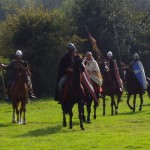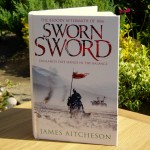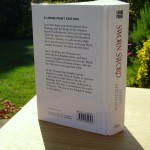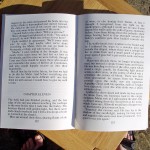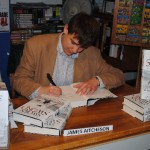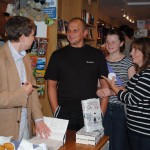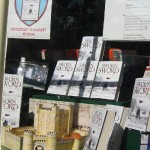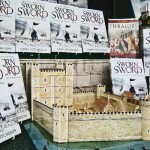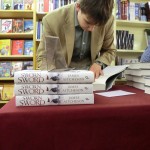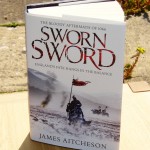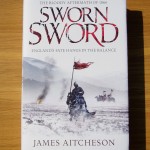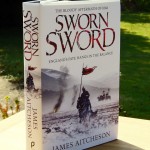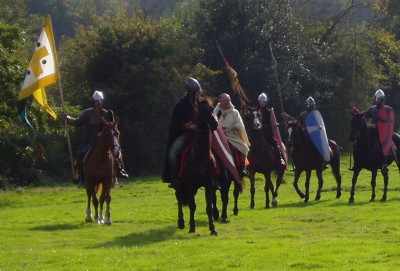
Norman knights led by Bishop Odo of Bayeux riding into battle under the papal banner. Image taken at English Heritage's annual Battle of Hastings re-enactment.
One of the most common questions that readers of Sworn Sword ask me is why I chose to write from the Norman perspective, rather than that of the English, as might be expected. In fact this was a decision that I made very early on in the novel’s development, when it was little more than a bundle of research notes and half-formed plot ideas.
I had long been fascinated by the Conquest, and I knew that what I wanted to write about were the years that followed the Battle of Hastings: a turbulent period as the Normans fought to consolidate their gains and subdue a country rife with rebellion. (The story of one of those rebellions, led by the dispossessed prince Eadgar, forms the backbone of the novel.) However, while the theme of the tragic-heroic struggle of the Anglo-Saxons against their foreign oppressors seemed to me very familiar, the Norman version of events was not generally as well known. Straightaway, then, I started to think about giving the tale of the Conquest a fresh twist, by telling it from the “other” point of view.
Every story has two sides. One man’s freedom fighter is another man’s insurgent. These sayings are so familiar as to have almost become clichés. By blurring the traditional distinction between the “good” English and the “evil” Normans, I hoped to show the period in a different light, to challenge readers’ sympathies and preconceptions. So far as I could see it was an angle that few authors had taken before, which made this a subject ripe for exploration.
Even so, to get the modern reader on the side of the foreigner is no easy task. Why this should be isn’t completely clear. After all, it goes almost without saying that the Englisc of the eleventh century are not at all the same people as the English of the twenty-first. Moreover, were it not for the Normans, we would not speak the language we do today, our systems of law and governance would be entirely different, as so too would our cultural heritage, since all are based on the foundations that they laid. The world we live in today owes as much, if not more to the Normans than it does to the Anglo-Saxons.
None of that, of course, is to deny that the Norman invasion was a brutal affair, or that it resulted in tremendous suffering for many thousands of people. In particular the campaign later known as the Harrying of the North, by which King William devastated Yorkshire in the winter of 1069-70, is testament to that. Nonetheless, to suggest that the Normans were universally bad men would be a gross oversimplification. Undoubtedly some came to England purely for self-serving reasons – out of desire for land and wealth, blood and glory – but I believe that many were also complex human beings who truly believed in the righteousness of their cause.
William of Normandy’s case for war in 1066 was built on two main pillars. The first of those was that the claim that he had been promised the succession by King Edward the Confessor in 1051. The second was that in c. 1064 Harold Godwineson had sworn on holy relics to uphold his right to the throne: a promise that he had subsequently broken when he himself seized the crown upon Edward’s death in January 1066. As far as the invaders were concerned, then, Harold was a perjurer and a usurper who had no right to the English crown. Worse than that, he was effectively made an enemy of God after Pope Alexander II gave his approval to William’s proposed invasion and sent him a consecrated banner under which to fight. To a Christian knight riding in the Conqueror’s army, there would have been little question that he was on the side of justice. William was the rightful king, anointed by God, and any who rose against him were to be crushed.
However, as Tancred finds out over the course of Sworn Sword, it is often difficult to tell who is right and who is wrong in any given situation. There are times when men will betray their principles in noble causes; on other occasions they will hold steadfastly to them even if it means the destruction of all that they hold dear. Englishmen will fight in the service of Normans and vice versa, to the extent that the “sides” become blurred and it becomes harder to talk about this period as a simple conflict between the two peoples, still less as one of good versus evil.
In reality the Conquest was a complicated and morally messy affair, and by offering a different perspective this is what I hope to show in Sworn Sword.
First copies of the large print edition of Sworn Sword arrived recently and look fantastic. Published by AudioGO, one of the best-established large print publishers in the UK, it won’t be released commercially but instead will be available mainly in libraries and hospitals, as well as from hard-of-sight charities.
Apart from a few cosmetic changes to the front cover design and a snappier blurb on the back, the overall look is not unlike that of the original hardback. It’s inside that the real differences become apparent, as the photos below show.
There’s news too of the German mass market paperback edition, published by Goldmann, which is due to hit the bookshelves in August 2012. The title, I’ve been told, will be Der Pakt der Schwerter, which translates literally as The Pact of Swords.
I can’t wait to see the finished product, and I’ll post pictures here on the blog as soon as I receive advance copies next year. Eventually I hope to post a picture of all the different editions of the book – hardcover, paperback, foreign and large print – lined up next to one another: a kind of Sworn Sword family photo!
After visits to Cambridge, Salisbury and Bath in recent weeks, the Sworn Sword tour stopped off last week in Wantage, Oxfordshire, for the very first Betjeman Festival. I was in conversation with Stephanie Merritt, better known as S.J. Parris, author of the excellent Elizabethan mysteries Heresy and Prophecy, about the attractions and challenges of historical fiction as a genre.
It’s always fascinating to discover the similarities and differences between other historical novelists’ approaches and my own, particularly when it comes to the all-important question of fact versus fiction. How much licence does a writer take when it comes to historical fact? Is it acceptable to alter the course of events in order to make for a better story? Or does the truth always take precedence, and must the fictional narrative be woven around that framework?
It was pointed out that whereas for Sworn Sword I have taken as my protagonist a fictional Norman knight, Stephanie’s novels feature the real-life character Giordano Bruno, a renegade monk and philosopher hailing from sixteenth-century Italy. While on the surface those might seem like two very different approaches to writing novels set in the past, when it comes to deciding how much licence to take with historical events, our views turned out to be very much alike. Whenever the drama of the story comes up against the facts, we both agreed, it is the story that has to win out. But when it comes to the small details that flesh out a setting and contribute to the period atmosphere – the food and drink or the décor of the time, for example – it’s important to get as much right as possible.
Of course the advantage in writing a novel set during the medieval period, at least compared with later centuries, is that the sources are sparser, the gaps in our knowledge wider and the uncertainties more pronounced. For the novelist, then, there are more opportunities to invent where things are not definitively known. Even so, getting the right balance between authenticity and a well-paced narrative is a tricky business. It’s a subject that I’m sure I’ll be returning to on this blog in future, as well as discussing during my upcoming events.
Speaking of which, coming up on Thursday 29 September is the first-ever History in the Court at Goldsboro Books in Cecil Court near Leicester Square in London. I’ll be there signing books and talking to readers about my work, along with as many as fifty other historical novelists including such luminaries of the genre as Bernard Cornwell and C.J. Sansom, both of whom were significant influences on my writing, as well as Ben Kane, Robyn Young, Simon Scarrow and many more besides.
Building on the success of the popular annual Crime in the Court event, it looks set to be a great evening and a unique chance to meet lots of your favourite historical authors in person. The event begins at 5pm and will carry on until 9pm. Tickets are £5 and can be purchased online
For details of all my upcoming engagements, visit my Events page. I’m adding new signings and talks all the time, especially in the run-up to Christmas. Already I’m starting to fill out my calendar for 2012 too, so keep checking back to find out when I’ll be visiting your area.
August has been a busy month, with the launch of Sworn Sword followed by a string of interviews, events and signings. So far the tour has taken me from Cambridge to London, the Cotswolds, Marlborough and Salisbury – and that’s just the beginning. Here’s a selection of the latest photos:
-

- A stack of Sworn Swords, signed, lined, dated and ready to go on the shelves at Goldsboro Books in London.
Many thanks to my hosts for these events: to the friendly folks at the Cotswold Bookstore in Moreton-in-Marsh, Gloucestershire, for not only providing freshly baked honey cakes but also creating the wonderful window display seen above, complete with medieval castle. Check out their blog for details of future signings, including one with Panama Oxridge, author of the ingenious novel Justin Thyme.
Especial thanks also to the White Horse Bookshop in Marlborough, Wiltshire, who last week put on a fantastic and well attended evening signing session and supplied both customers and author with wine. They’ll be supporting the Marlborough LitFest, where I’ll be appearing as part of the Wiltshire Writers panel on Friday 23 September.
For further news of signings, talks, readings and festival appearances, take a look at my Events page. More dates are being added all the time.
The latest addition to the list is a talk at the Durham Book Festival on Friday 21 October. Returning to the place where Sworn Sword – and Tancred’s journey – begins, I’ll be speaking about the novel’s connection to the city and more generally about my inspiration for the series, and what particularly fascinates me about the Norman Conquest.
The first advance copies of the Sworn Sword hardback came back from the printers this weekend and are looking terrific. Thanks to all those at Preface Publishing who have helped to make this book happen, as well as to the cover illustrator Tim Byrne, whose design graces the jacket. I fell in love with the proposed cover from the moment it was first presented to me, and it’s turned out brilliantly.
So, after months of painstaking preparation and seemingly endless edits, and consultation on everything from the jacket copy down to the typeface itself, the finished product is finally here: no fewer than 416 bound pages, with the most striking, atmospheric and dramatic cover you will see on bookshelves this summer – even if I do say so myself.
With just one month to go until publication, then, here’s a sneak preview:
[Click on the thumbnails to view the images in higher resolution.]
Welcome to www.jamesaitcheson.com, my official website, and to this blog, where I will be posting regularly with all the latest news about my debut novel, Sworn Sword, which is due to be released on 4 August this year.
On this blog you’ll find also information on the forthcoming sequels, details about readings, signings and other events, as well as news and views on matters historical and literary.
I plan to add more features to the site as the publication date draws nearer, so watch this this space in the coming weeks. To keep up with all the latest updates you can also sign up to my official Facebook page or follow my official Twitter feed.

